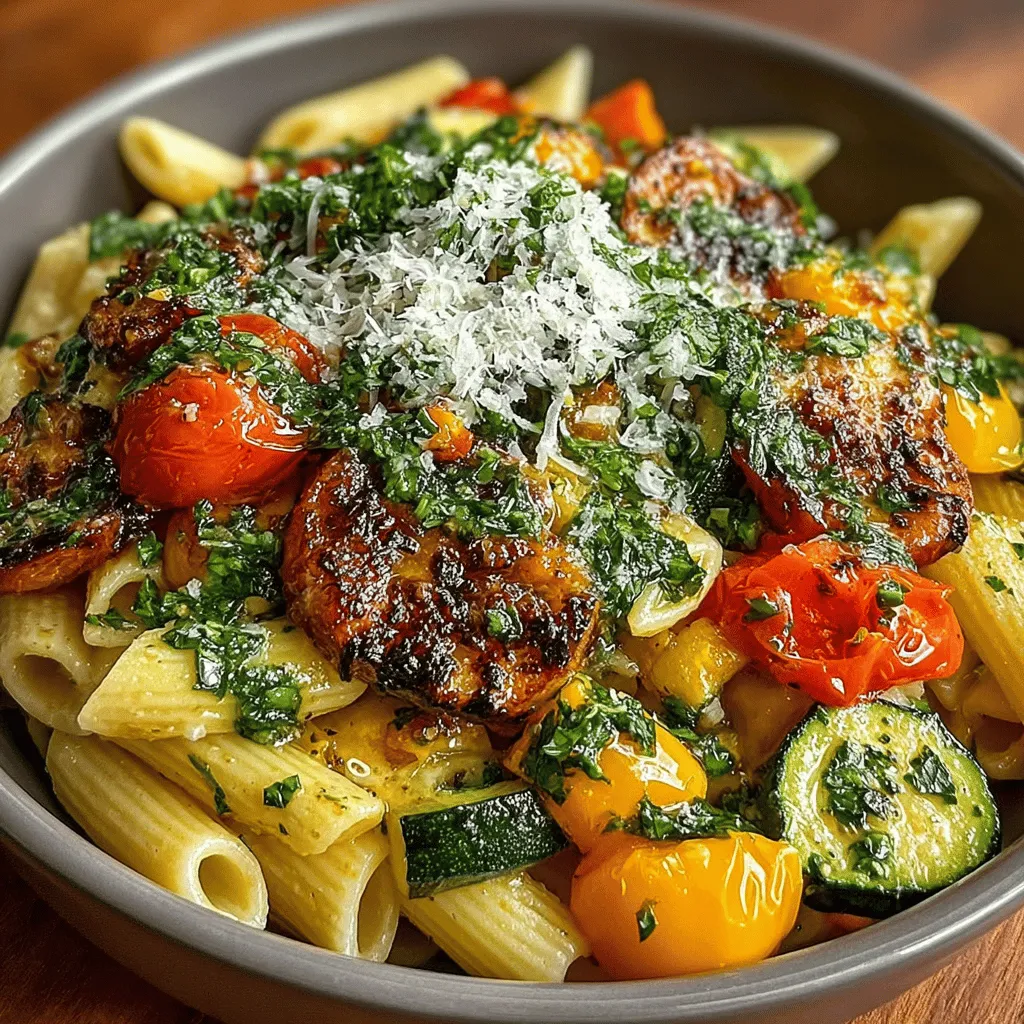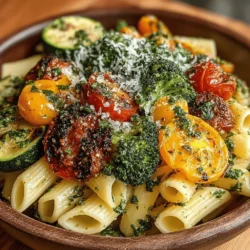Introduction to Vibrant Pasta Primavera
Pasta primavera is more than just a dish; it’s a celebration of the fresh, vibrant flavors that seasonal vegetables offer, all wrapped in the comforting embrace of pasta. Originating from Italy, this classic dish has become a staple in kitchens around the world, particularly among those seeking a delicious way to incorporate more plant-based meals into their diets. The combination of al dente pasta, a medley of colorful vegetables, and a fragrant garlic herb sauce creates a visually stunning and nourishing meal that appeals to both the eyes and the palate.
At its core, pasta primavera is about embracing the bounty of fresh produce. Whether it’s the crunch of bell peppers, the softness of zucchini, or the burst of sweetness from cherry tomatoes, each ingredient plays a crucial role in crafting a dish that is as nutritious as it is delightful. This vibrant pasta dish not only satisfies hunger but also provides a wealth of vitamins and minerals, making it an excellent choice for health-conscious diners.
In this article, we will delve into the ingredients that make this dish shine, explore the cooking techniques that will elevate your pasta primavera to new heights, and uncover the nutritional benefits that come with each bite. Let’s get started on this culinary journey to create a vibrant pasta primavera with garlic herb sauce.
Understanding the Ingredients
Creating a delicious pasta primavera begins with understanding its core components. Each ingredient contributes to the overall flavor, texture, and nutritional profile of the dish.
Overview of Pasta Choices
The choice of pasta is fundamental to the success of your pasta primavera. While spaghetti is a classic option, penne is often preferred due to its ability to hold onto the sauce and vegetables thanks to its tubular shape. Both pasta types can serve as an excellent base, but the choice ultimately depends on personal preference.
When selecting your pasta, consider opting for whole-grain or gluten-free varieties to enhance the dish’s nutritional value. Whole-grain pasta provides additional fiber, which aids digestion, while gluten-free options are perfect for those with dietary restrictions.
Fresh Vegetables
The heart of pasta primavera lies in its fresh vegetables. Seasonal produce not only adds vibrant colors but also infuses the dish with a range of flavors and nutrients. Here are some key vegetables that make this dish a standout:
– Bell Peppers: Available in various colors, bell peppers add sweetness and crunch. They are rich in vitamin C and antioxidants, which help boost the immune system.
– Zucchini: This versatile vegetable has a mild flavor and soft texture when cooked. Zucchini is low in calories and high in vitamins A and C, making it a great addition to any dish.
– Cherry Tomatoes: These sweet, juicy morsels burst with flavor and are packed with lycopene, a powerful antioxidant that promotes heart health.
– Broccoli: Known for its numerous health benefits, broccoli adds a satisfying crunch and is an excellent source of vitamins K and C, as well as fiber.
The beauty of pasta primavera is in its adaptability; feel free to swap in your favorite seasonal vegetables to make it your own.
Flavor Enhancers
To elevate the flavors of your pasta primavera, garlic and herbs play a crucial role. Fresh garlic is a key ingredient that adds depth and aroma. It’s essential to sauté the garlic just right—too long, and it can become bitter; too short, and it may not impart enough flavor.
Fresh herbs, particularly basil and parsley, can transform your dish from ordinary to extraordinary. Basil offers a sweet, peppery flavor that complements the vegetables beautifully, while parsley adds a fresh, bright note. Don’t underestimate their importance; fresh herbs can make a significant difference in the overall taste.
Adding a Zesty Touch
A splash of lemon juice can work wonders in balancing the flavors of your pasta primavera. The acidity of lemon juice cuts through the richness of the sauce and brightens the overall dish, making every bite refreshing. It’s a simple addition that can elevate your meal to new heights, ensuring that it’s not only flavorful but also feels light and invigorating.
The Cheese Factor
While pasta primavera is often celebrated for its plant-based goodness, a sprinkle of freshly grated Parmesan cheese can enrich the dish and add a savory umami flavor. Parmesan cheese not only enhances the taste but also provides a source of protein and calcium. For a vegan version, consider using nutritional yeast as a cheese substitute, which will impart a similar savory taste without dairy.
Step-by-Step Preparation of Vibrant Pasta Primavera
Now that we’ve explored the ingredients, it’s time to dive into the preparation of your vibrant pasta primavera. This step-by-step guide will ensure that you create a dish that’s not only delicious but also visually appealing.
Cooking the Pasta
The first step in preparing your pasta primavera is cooking the pasta. It’s important to use a large pot of water for boiling, and don’t forget to generously salt it. Salting the water enhances the flavor of the pasta itself. Cook your chosen pasta according to the package instructions, aiming for an al dente texture. This means the pasta should be firm to the bite, as it will continue to cook slightly when combined with the sauce and vegetables.
Reserve a cup of pasta water before draining; this starchy water can be used later to adjust the consistency of your sauce.
Sautéing the Aromatics
While the pasta is cooking, heat a generous amount of olive oil in a large skillet over medium heat. Once the oil is hot, add minced garlic. The key to perfect sautéed garlic is to keep an eye on it; you want it to become fragrant and slightly golden, which usually takes about 30 seconds to a minute. Be careful not to burn the garlic, as this will impart a bitter taste to your dish.
Incorporating the Vegetables
Once the garlic is sautéed, it’s time to add the fresh vegetables. Start with those that take longer to cook, like broccoli and bell peppers, allowing them to soften and develop their flavors. After a few minutes, add the zucchini and cherry tomatoes, stirring occasionally to ensure even cooking.
To achieve the perfect texture, aim for vegetables that are cooked but still retain a bit of crunch. This will create a delightful contrast with the pasta and sauce, enhancing the overall eating experience.
As you sauté the vegetables, feel free to add a pinch of salt and pepper to taste, as well as any fresh herbs or spices that will complement your dish. This is your opportunity to infuse the vegetables with flavor and make the dish uniquely yours.
With the pasta cooked and the vegetables sautéed to perfection, you’re well on your way to creating a vibrant pasta primavera that will impress both family and friends. Stay tuned for the next steps, where we will bring all these elements together to finalize this delightful dish.

Timing for Adding Each Vegetable for Optimal Tenderness
Achieving the perfect texture in your pasta primavera is all about timing. Each vegetable has its unique cooking time, and knowing when to add them is crucial for optimal tenderness. Start with the firmer vegetables that require a longer cooking time:
1. Carrots: These should be added first, as they take the longest to soften. Slice them thinly to ensure they cook evenly.
2. Bell Peppers: Next, add bell peppers. They add a sweet crunch and only need a few minutes to become tender.
3. Broccoli: Add broccoli florets after the bell peppers; they will cook in about 3-4 minutes.
4. Zucchini and Yellow Squash: These soft vegetables should be added last, as they only need about 2-3 minutes to achieve a tender yet slightly crisp texture.
By following this order, you ensure that each vegetable maintains its flavor and crunch, contributing to the dish’s overall vibrancy.
Combining Ingredients
Once your vegetables are cooked to the desired tenderness, it’s time to combine them with the pasta. Drain your pasta, reserving a cup of the cooking water. The reserved water is key to achieving a light and flavorful sauce.
In a large mixing bowl or directly in your skillet, add the drained pasta to the sautéed vegetables. Pour in the garlic herb sauce, starting with a moderate amount and adding more as needed. The combination of the hot pasta and vegetables will help the sauce adhere beautifully.
The Importance of Tossing Pasta and Vegetables
Tossing your pasta and vegetables together is essential for evenly distributing the garlic herb sauce. Use tongs or a large fork to gently mix everything together, ensuring every bite is infused with flavor. This step not only enhances the taste but also allows the heat from the pasta to slightly cook the sauce, creating a harmonious blend.
How to Achieve a Light Sauce with Reserved Pasta Water
One of the secrets to a light and flavorful sauce is the addition of reserved pasta water. This starchy water helps to emulsify the sauce, making it creamy without adding calories or heaviness. Start by adding a small amount of the reserved water, mixing thoroughly, and assessing the consistency. If the sauce feels too thick or dry, gradually incorporate more pasta water until you reach your desired consistency. The goal is a silky sauce that clings to the pasta and vegetables without feeling greasy.
Final Touches
Stirring in Fresh Herbs and Cheese: When and How to Add Them
To elevate the flavors of your vibrant pasta primavera, consider stirring in fresh herbs and cheese as the final touches. Fresh basil, parsley, or oregano can add a burst of flavor and color.
1. Fresh Herbs: Chop your chosen herbs finely and add them to the pasta primavera just before serving. This preserves their vibrant color and fresh taste, ensuring they don’t lose their flavor through prolonged cooking.
2. Cheese: If you’re including cheese, such as Parmesan or a dairy-free alternative, add it after the herbs. This allows the cheese to melt slightly into the warm pasta, enriching the dish without overpowering it.
Mix everything gently to ensure an even distribution, and prepare to serve.
Nutritional Benefits of Pasta Primavera
Low-Calorie and Nutrient-Dense
Pasta primavera is an excellent choice for those looking to enjoy a delicious meal without excessive calories. The combination of vegetables and pasta creates a nutrient-dense dish that is filling yet light. Generally, a serving of pasta primavera contains around 300-400 calories, depending on the portion size and the amount of sauce used.
Analyzing the Calorie Count and Nutrient Profile per Serving
Each serving of vibrant pasta primavera provides a balanced array of macronutrients. Typically, you can expect:
– Carbohydrates: 50-60g, primarily from the pasta and vegetables.
– Protein: 8-12g, which can be increased with the addition of beans or lentils.
– Fats: 7-10g, depending on the amount of oil used in the sauce.
This dish is not only low in calories but also rich in vitamins, minerals, and antioxidants, making it a great option for a healthy diet.
Fiber-Rich Ingredients
The variety of vegetables in pasta primavera contributes to its fiber content, which is vital for digestive health. Each serving can provide 5-7g of dietary fiber, helping to promote a healthy gut and keeping you feeling fuller for longer.
Benefits of Incorporating a Variety of Vegetables for Digestive Health
Adding a colorful mix of vegetables not only enhances the dish’s visual appeal but also ensures a range of nutrients and fiber. Vegetables like broccoli, zucchini, and bell peppers are excellent sources of dietary fiber, vitamins A and C, and other essential nutrients that support overall health and wellness.
Plant-Based Goodness
Emphasizing vegetables in your diet can have numerous health benefits. A vegetable-forward diet is linked to a reduced risk of chronic diseases, improved heart health, and better weight management. The vibrant pasta primavera allows you to enjoy a hearty meal while reaping the benefits of a plant-rich lifestyle.
Customizing for Dietary Needs
Suggestions for Gluten-Free or Dairy-Free Adaptations
One of the best aspects of pasta primavera is its versatility. For those following a gluten-free diet, substitute traditional pasta with gluten-free options such as brown rice pasta, quinoa pasta, or even spiralized vegetables like zucchini noodles.
For a dairy-free adaptation, you can either omit cheese or use plant-based alternatives like nutritional yeast, which adds a cheesy flavor without the dairy.
Serving Suggestions and Pairings
Ideal Accompaniments
Serving your vibrant pasta primavera alongside complementary dishes enhances the overall dining experience. Consider these ideal accompaniments:
– Garlic Bread: A classic pairing, warm, toasted garlic bread provides a crunchy contrast to the soft pasta and veggies.
– Side Salad: A fresh side salad with a light vinaigrette can balance the richness of the pasta, providing a refreshing crunch.
Beverage Pairings
Selecting the right beverages can elevate your meal. Here are some recommendations:
– Wine: A crisp white wine, such as Sauvignon Blanc or Pinot Grigio, pairs beautifully with the flavors of pasta primavera, enhancing the fresh herb notes.
– Non-Alcoholic: For a non-alcoholic option, try sparkling water infused with lemon or a herbal iced tea, which can cleanse the palate between bites.
Presentation Tips
Plating your pasta primavera can greatly enhance its appeal. Here are some presentation tips:
1. Use a Large Shallow Bowl: This allows the vibrant colors of the vegetables to shine through.
2. Garnish: Top with extra herbs or a sprinkle of cheese for added visual interest.
3. Add Color: Arrange the vegetables in a visually appealing manner, showcasing the variety and freshness.
Conclusion: Enjoying Vibrant Pasta Primavera
Vibrant pasta primavera with garlic herb sauce is more than just a meal; it is a celebration of fresh ingredients and simple cooking techniques. This dish not only satisfies your taste buds but also nourishes your body with its wholesome ingredients. By following the steps outlined in this article, you can create a colorful, healthy pasta dish that is sure to impress at any table. Enjoy the delightful flavors and the joy of cooking with fresh, seasonal produce. Whether as a weeknight dinner or a dish for special occasions, pasta primavera is a versatile choice that promises to bring a burst of color and flavor to your dining table.


